2015春冀教版英语八下Unit 3《Aimals Are Our Friends》每课一练
- 格式:doc
- 大小:32.00 KB
- 文档页数:4


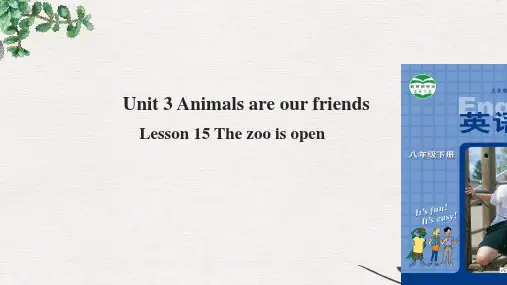
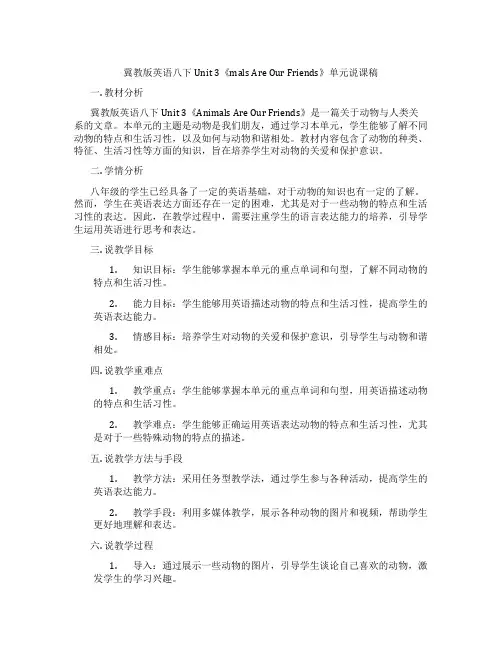
冀教版英语八下Unit 3《mals Are Our Friends》单元说课稿一. 教材分析冀教版英语八下Unit 3《Animals Are Our Friends》是一篇关于动物与人类关系的文章。
本单元的主题是动物是我们朋友,通过学习本单元,学生能够了解不同动物的特点和生活习性,以及如何与动物和谐相处。
教材内容包含了动物的种类、特征、生活习性等方面的知识,旨在培养学生对动物的关爱和保护意识。
二. 学情分析八年级的学生已经具备了一定的英语基础,对于动物的知识也有一定的了解。
然而,学生在英语表达方面还存在一定的困难,尤其是对于一些动物的特点和生活习性的表达。
因此,在教学过程中,需要注重学生的语言表达能力的培养,引导学生运用英语进行思考和表达。
三. 说教学目标1.知识目标:学生能够掌握本单元的重点单词和句型,了解不同动物的特点和生活习性。
2.能力目标:学生能够用英语描述动物的特点和生活习性,提高学生的英语表达能力。
3.情感目标:培养学生对动物的关爱和保护意识,引导学生与动物和谐相处。
四. 说教学重难点1.教学重点:学生能够掌握本单元的重点单词和句型,用英语描述动物的特点和生活习性。
2.教学难点:学生能够正确运用英语表达动物的特点和生活习性,尤其是对于一些特殊动物的特点的描述。
五. 说教学方法与手段1.教学方法:采用任务型教学法,通过学生参与各种活动,提高学生的英语表达能力。
2.教学手段:利用多媒体教学,展示各种动物的图片和视频,帮助学生更好地理解和表达。
六. 说教学过程1.导入:通过展示一些动物的图片,引导学生谈论自己喜欢的动物,激发学生的学习兴趣。
2.新课呈现:教师引导学生通过观察图片和阅读文章,了解不同动物的特点和生活习性。
3.课堂活动:学生分组讨论,用英语描述所学的动物的特点和生活习性。
4.语言练习:学生进行角色扮演,模拟与动物的对话,提高学生的英语表达能力。
5.巩固活动:学生完成相关的练习题,巩固所学知识。
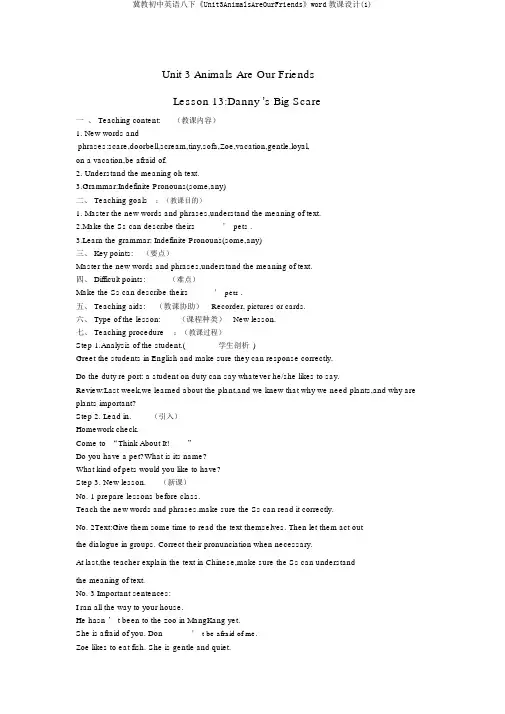
Unit 3 Animals Are Our FriendsLesson 13:Danny ’s Big Scare一、 Teaching content:(教课内容)1.New words andphrases:scare,doorbell,scream,tiny,sofa,Zoe,vacation,gentle,loyal,on a vacation,be afraid of.2. Understand the meaning oh text.3.Grammar:Indefinite Pronouns(some,any)二、 Teaching goals:(教课目的)1. Master the new words and phrases,understand the meaning of text.2.Make the Ss can describe theirs’ pets .3.Learn the grammar: Indefinite Pronouns(some,any)三、 Key points:(要点)Master the new words and phrases,understand the meaning of text.四、 Difficult points:(难点)Make the Ss can describe theirs’ pets .五、 Teaching aids:(教课协助)Recorder, pictures or cards.六、 Type of the lesson:(课程种类)New lesson.七、 Teaching procedure:(教课过程)Step 1.Analysis of the student.(学生剖析)Greet the students in English and make sure they can response correctly.Do the duty re port: a student on duty can say whatever he/she likes to say.Review:Last week,we learned about the plant,and we knew that why we need plants,and why are plants important?Step 2. Lead in.(引入)Homework check.Come to “Think About It!”Do you have a pet?What is its name?What kind of pets would you like to have?Step 3. New lesson.(新课)No. 1 prepare lessons before class.Teach the new words and phrases.make sure the Ss can read it correctly.No. 2Text:Give them some time to read the text themselves. Then let them act outthe dialogue in groups. Correct their pronunciation when necessary.At last,the teacher explain the text in Chinese,make sure the Ss can understandthe meaning of text.No. 3 Important sentences:I ran all the way to your house.He hasn ’ t been to the zoo in MangKang yet.She is afraid of you. Don’ t be afraid of me.Zoe likes to eat fish. She is gentle and quiet.I ’ d like to have a dog. Dogs are friendly and loyal.No. 4 Project:Work in groups.Interview your group members about their petsand complete the survey.Do you have a pet?If yes,what is it?If no,what pet would you like to have?Can you describe your pet?What does it look like?What does it eat?What does it like/dislike doing?How do you look after it?No. 5 Grammar: Indefinite Pronouns(some,any)一.Some 的用法1.some : adj.(多用于一定句、希望获得对法一定回答的疑问句中)1)修饰可数名词复数,指三个或三个以上,“一些、若干”eg. Some children like playing in the park.Would you like some apples?2)修饰不行数名词,“一些、若干”eg. There is some water in the bottle.Would you like some tea or coffee?3)修饰可数名词单数,“未确指的人、事物或地址”eg. Some man at the door is asking to see you.2.some:pron.“一些人、一些物;有些人、有些物”eg. There are many people in the park. Some are walking. Some are talking.eg. Some of the dumplings are made of shrimps(虾,小虾).二.Any 的用法1.any:adj.(多用于否认句、疑问句)1)修饰可数名词复数,“任何数量的人或物”eg. I didn’t eat any apples.eg. Are there any stamps in the drawer?2)修饰不行数名词,“任何量的”eg. Can you speak any French?3)用于一定句中修饰单数可数名词,“任何一个”eg. Give me a pen ---any pen will be OK.2.any:pron.“任何一个人/ 物”eg. She didn’t spen d any of the money.总结:表示一些时,some 用于一定句和希望获得一定回答的疑问句中;any 用于否认句和疑问句中 . 参照书后语法P151No. 6 Finish“ Let’ s Do It!”Step 4. Play the tape for the Ss to follow.Make the Ss listen the text,then let them read follow the tape.Step 5.Summary.(小结)Sum up the text what we learned,the new words,phrases,and sentences.Sum up the grammar.Step 6. Homework.(作业)Finish the activity book and the practice.Copy the new words and phrases twice.Step 7.Blackboard-writing:(板书)The new words,the master phrases,important sentences.The grammar and practice.八.Teaching reflection: (教后反省)Lesson 14:Amazing Animals一、 Teaching content:(教课内容)1. New words and phrases:long-eared,jerboa,mouse,kiwi,lay,long-nosed,eggplant, shake,flap,avoid,be famous for,up to.2. Understand the meaning oh text.3.The grammar: Indefinite Pronouns(some,any)二、 Teaching goals:(教课目的)1.Master the new words and phrases,understand the meaning of text.2.Ask some Ss to talk about the animals we know.3.Make the Ss learn about the world more.三、 Key points:(要点)Master the new words and phrases,understand the meaning of text.四、 Difficult points:(难点)Ask some Ss to talk about the animals we know.五、 Teaching aids:(教课协助)Recorder, pictures or cards.六、 Type of the lesson:(课程种类)New lesson.七、 Teaching procedure:(教课过程)Step 1.Analysis of the student.(学生剖析)Homework check.Review: the grammar-- Indefinite Pronouns(some,any)In last lesson,we learned how to describe our pets,and we knew that,in our daily life we needn ’ t only plants but also animals.So,the animals are as important asthe plants.Step 2. Lead in.(引入)1.Greet the students in English and make sure they can response correctly.Do the duty report: a student on duty can say whatever he/she likes to say.2.Think About It:Can you name some animals you have never seen before?What animals do you think are amazing?Why?Step 3. New lesson.(新课)No. 1 prepare lessons before class.Teach the new words and phrases.make sure the Ss can read it correctly.No. 2Text:Give them some time to read the text themselves. Then let them act out the dialogue in groups. Correct their pronunciation when necessary.At last,the teacher explain the text in Chinese,make sure the Ss can understand the meaning of text.No. 3Important sentences:They are famous for their large noses.It looks like a bird with its large wings.You can see flying fish all over the world.No. 4 Finish“ Let’ s Do It!”Step 4. Play the tape for the Ss to follow.Make the Ss listen the text,then let them read follow the tape.Step 5.Summary.(小结)Sum up the text what we learned,the new words,phrases,and sentences.Sum up the grammar.Step 6. Homework.(作业)Finish the activity book and the practice.Copy the new words and phrases twice.Step 7.Blackboard-writing:(板书)The new words,the master phrases,important sentences.The grammar and practice.八.Teaching reflection: (教后反省)Lesson 15:The Zoo Is Open一、 Teaching content:(教课内容)1.New words and phrases:dangerous,mainly,bamboo,giraffe,instead of.2.Understand the meaning oh text.3.Grammar: Indefinite Pronouns(some,any)二、 Teaching goals:(教课目的)1.Master the new words and phrases,understand the meaning of text.2.Talk about the animals in the zoo.3.Make the Ss know why we need animals.三、 Key points:(要点)Talk about the animals in the zoo.四、 Difficult points:(难点)五、 Teaching aids:(教课协助)Recorder, pictures or cards.六、 Type of the lesson:(课程种类)New lesson.七、 Teaching procedure:(教课过程)Step 1.Analysis of the student.(学生剖析)Homework check.Review:Ask some Ss to talk about the animals in lesson 14.We learned about somespecial animals and we knew the difference between the animals and the pets.Step 2. Lead in.(引入)Greet the students in English and make sure they can response correctly.Do the duty report: a student on duty can say whatever he/she likes to say.Come to “Think about It!”What animals do you think are dangerous?Why?What rules should we obey at the zoo?Step 3. New lesson.(新课)No. 1 prepare lessons before class.Come to the vocabulary.Teach the new words and phrases.make sure the Ss can read it correctly.No. 2Text:Give them some time to read the text themselves. Then let them act outthe dialogue in groups. Correct their pronunciation when necessary.At last,the teacher explain the text in Chinese,make sure the Ss can understandthe meaning of text.No. 3Important phrases:go to the zoo arrive at go through point to take photos wake uplots of instead ofNo. 4 Project:We’re going to the zoo!’ t forget to answer these questions:When did you go to the zoo?Who went to the zoo with you?What animals did you see?What animals did you like best?Why?Did you feed any animals?Are zoos good for animals?Why or why not?No. 5 Finish“ Let’ s Do It!”Step 4. Play the tape for the Ss to follow.Make the Ss listen the text,then let them read follow the tape.Step 5.Summary.(小结)Sum up the text what we learned,the new words,phrases,and sentences.Sum up the grammar.Step 6. Homework.(作业)Finish the activity book and the practice.Copy the new words and phrases twice.Step 7.Blackboard-writing:(板书)The new words,the master phrases,important sentences.The grammar and practice.八.Teaching reflection:(教后反省)Lesson 16:The Bear Escaped!一、 Teaching content: (教课内容)1. New words and phrases:escape,fierce,protect,fool,wait a minute,You’ re joking,aren ’ t you?April Fool s’ Day2. Understand the meaning oh text.二、 Teaching goals :(教课目的)1. Master the new words and phrases,understand the meaning of text.2.Learn about what is April Fools ’ Day,and know about what we can do on that day.3.Make the Ss learn about some interesting things in our life.三、 Key points: (要点)Learn about what is April Fools ’ Day,and know about what we can do on that day.四、 Difficult points: (难点)Make the Ss learn about some interesting things in our life.五、 Teaching aids: (教课协助) Recorder, pictures or cards.六、 Type of the lesson: (课程种类) New lesson.七、 Teaching procedure :(教课过程)Step 1.Analysis of the student.( 学生剖析 )Homework check.Review:Ask some Ss to talk about the animals in the zoo,and what did we learn inlast lesson?Review the grammar: Indefinite Pronouns(some,any)Step 2. Lead in. (引入)1.Greet the students in English and make sure they can response correctly.Do the duty report: a student on duty can say whatever he/she likes to say.e to“ Think About It!”What do you know about April Fool s’ Day?Have you ever played a trick on a friend?What did you do?T:Introduce the April Fool s’ Day,and tell the Ss what they can do on that day.Then we will learn the text about Danny’s activity on that day.Step 3. New lesson.(新课)No. 1 prepare lessons before class.Teach the new words and phrases.make sure the Ss can read it correctly.No. 2 Text:Give them some time to read the text themselves. Then let them act outthe dialogue in groups. Correct their pronunciation when necessary.At last,the teacher explain the text in Chinese,make sure the Ss can understandthe meaning of text.No.3Important phrases:Danny jumps up and down.Wait a minute. Get out ofYou’ re joking,aren ’ t you?Play a trick/joke......on sb.No. 4 Culture Tip:April Fool s’ Day is the first day of April.In most Western countries,people liketo play jokes on each other.When you play a joke on somebody,you laugh and theylaugh,too.But don ’ t play jokes that make other people sad or mad.April Fools ’ Day is meant to be fun for everyone.No. 5 Finish “ Let ’ s Do It! ”Step 4. Play the tape for the Ss to follow.Make the Ss listen the text,then let them read follow the tape.Step 5.Summary. (小结)Sum up the text what we learned,the new words,phrases,and sentences.Sum up the grammar.Step 6. Homework. (作业)Finish the activity book and the practice.Copy the new words and phrases twice.Step 7.Blackboard-writing: (板书)The new words,the master phrases,important sentences.The grammar and practice.八.Teaching reflection: (教后反省)Lesson 17:Save the Tigers一、 Teaching content:(教课内容)1. New words and phrases:century,fur,symbol,courage,brave,chain,balance,reason,disappear,kill,cut,decrease,at the beginning of,drop to,food chain,in balance,indanger,cut down,as well.2. Understand the meaning oh text.3.Learn about the animals—tigers.二、 Teaching goals:(教课目的)1.Master the new words and phrases,understand the meaning of text.2.Make the Ss can talk about the animals in English.3.Ask the Ss to discuss how to protect the animals.三、 Key points:(要点)New words and phrases,the meaning of text.四、 Difficult points:(难点)Talking about the animals,and how to protect the animals.五、 Teaching aids:(教课协助)Recorder, pictures or cards.六、 Type of the lesson:(课程种类)New lesson.Step 1.Analysis of the student.(学生剖析)Homework check.Review:In last lesson,we played a joke on Danny,then we learned about oneabout April Fool ’ s animal — bear,and we know that also learnedDay.Step 2. Lead in.(引入)1.Greet the students in English and make sure they can response correctly.Do the duty report: a student on duty can say whatever he/she likes to say.e to "THINK ABOUT IT".Where can you usually see a tiger?Do you know tigers need our help?Why or why not?Step 3. New lesson.(新课)No. 1 prepare lessons before class.Teach the new words and phrases.make sure the Ss can read it correctly.No. 2Text:Give them some time to read the text themselves. Then let them act outthe dialogue in groups. Correct their pronunciation when necessary.At last,the teacher explain the text in Chinese,make sure the Ss can understandthe meaning of text.No. 3Important phrases:At the beginning of the 20th century,In recent years,tigers have been in danger of disappearing.No. 4Learning Tip:There are currently six types of tigers:the Bengal tiger,the Siberian tiger,theSumatran tiger, the Malayan tiger,the Indochinese tiger and the South China tiger. No. 5 Finish“ Let ’ s Do It! ”Step 4. Play the tape for the Ss to follow.Make the Ss listen the text,then let them read follow the tape.Step 5.Summary.(小结)Sum up the text what we learned,the new words,phrases,and sentences.Sum up the grammar.Step 6. Homework.(作业)Finish the activity book and the practice.Copy the new words and phrases twice.Step 7.Blackboard-writing:(板书)The new words,the master phrases,important sentences.The grammar and practice.八.Teaching reflection: (教后反省)Lesson 18:Friendship Between Animals一、 Teaching content:(教课内容)1. New words and phrases:friendship,rhino,skin,warn,insect,relationship,survive,Owen,mzee,hippo,tortoise,truly,boundary,touch one’ s heart.2. Understand the meaning oh text.3.The grammar:some,any.二、 Teaching goals:(教课目的)1.Master the new words and phrases,understand the meaning of text.2.Learn about the friendship between animals,and some interesting stories.3.From this text,we should know our friendship is important to us.三、 Key points: (要点)Learn about the friendship between animals,and some interesting stories.四、 Difficult points: (难点)From this text,we should know our friendship is important to us.五、 Teaching aids: (教课协助) Recorder, pictures or cards.六、 Type of the lesson: (课程种类) New lesson.七、 Teaching procedure :(教课过程)Step 1.Analysis of the student.( 学生剖析 )Homework check.Review:In last lesson,we learned another animal — tiger.Now ask some Ss to talk about the tiger in English.And how to protect the tigers,because tigers have beenin danger of disappearing.Step 2. Lead in. (引入)1.Greet the students in English and make sure they can response correctly.Do the duty report: a student on duty can say whatever he/she likes to say.e to "THINK ABOUT IT".Do you think there is friendship between animals?What different animals have you seen living well together?Step 3. New lesson.(新课)No. 1 prepare lessons before class.Teach the new words and phrases.make sure the Ss can read it correctly.No. 2Text:Give them some time to read the text themselves. Then let them act outthe dialogue in groups. Correct their pronunciation when necessary .Read the lesson and answer the questions:What is the relationship between the egret and the rhino?Who is Owen?Who is Mzee?How did people feel when they heard the story of friendship between Owen and Mzee?Do good friends need to say something to show they care?Read the text silently and check the answers. Let the students discuss the mainidea of the passage in details. At last,the teacher explain the text in Chinese,make sure the Ss can understand the meaning of text.No. 3The grammar:some,any.一.Some 的用法1.some : adj.(多用于一定句、希望获得对法一定回答的疑问句中)1)修饰可数名词复数,指三个或三个以上,“一些、若干”eg. Some children like playing in the park.Would you like some apples?2)修饰不行数名词,“一些、若干”eg. There is some water in the bottle.Would you like some tea or coffee?3)修饰可数名词单数,“未确指的人、事物或地址”eg. Some man at the door is asking to see you.2.some:pron.“一些人、一些物;有些人、有些物”eg. There are many people in the park. Some are walking. Some are talking.eg. Some of the dumplings are made of shrimps(虾,小虾).二.Any 的用法1.any:adj.(多用于否认句、疑问句)1)修饰可数名词复数,“任何数量的人或物”eg. I didn’t eat any apples.eg. Are there any stamps in the drawer?2)修饰不行数名词,“任何量的”eg. Can you speak any French?3)用于一定句中修饰单数可数名词,“任何一个”eg. Give me a pen ---any pen will be OK.2.any:pron.“任何一个人/ 物”eg. She didn’t spend any of the money.总结:表示一些时,some 用于一定句和希望获得一定回答的疑问句中;any 用于否认句和疑问句中 .No. 4 Finish“ Let’ s Do It!”Step 4. Play the tape for the Ss to follow.Make the Ss listen the text,then let them read follow the tape.Step 5.Summary.(小结)Sum up the text what we learned,the new words,phrases,and sentences. Sum up the grammar.Step 6. Homework.(作业)Finish the activity book and the practice.Copy the new words and phrases twice.Step 7.Blackboard-writing:(板书)The new words,the master phrases,important sentences.The grammar and practice.八.Teaching reflection:(教后反省)Unit Review一、 Teaching content:(教课内容)1. Review the words and phrases in this unit.2.Talk about the animals.3.Review the grammar: some,any.二、 Teaching goals:(教课目的)1.Remember the words and phrases.2. Encourage students to talk about the animals in English.3.Make the Ss understand the animals are important to us.三、 Key points:(要点)Encourage students to talk about the animals in English.四、 Difficult points:(难点)How to protect the animals.How to protect the environment.The grammar:some,any.五、 Teaching aids:(教课协助)Recorder, pictures or cards.六、 Type of the lesson:(课程种类)Review.七、 Teaching procedure:(教课过程)Step 1.Building Your VocabularyReview all words and phrases in this unit.First,the Ss finish the practice on the page of 46,then check the answers as a class.Step 2. Grammar in UseNo.1 Review:some,any.一.Some 的用法1.some : adj. (多用于一定句、希望获得对法一定回答的疑问句中)1)修饰可数名词复数,指三个或三个以上,“一些、若干” eg. Some children like playing in the park.Would you like some apples?2)修饰不行数名词,“一些、若干”eg. There is some water in the bottle.Would you like some tea or coffee?3)修饰可数名词单数,“未确指的人、事物或地址”eg. Some man at the door is asking to see you.2.some:pron.“一些人、一些物;有些人、有些物”eg. There are many people in the park. Some are walking. Some are talking.eg. Some of the dumplings are made of shrimps(虾,小虾).二.Any 的用法1.any:adj.(多用于否认句、疑问句)1)修饰可数名词复数,“任何数量的人或物”eg. I didn’t eat any apples.eg. Are there any stamps in the drawer?2)修饰不行数名词,“任何量的”eg. Can you speak any French?3)用于一定句中修饰单数可数名词,“任何一个”eg. Give me a pen ---any pen will be OK.2.any:pron. “任何一个人/ 物”eg. She didn ’t spend any of the money.总结:表示一些时,some 用于一定句和希望获得一定回答的疑问句中;any 用于否认句和疑问句中 .No.2.Finish the practice on the page of 46.Step 3. Listening and SpeakingPlay the tape for the Ss to follow.Make the Ss listen the text,then let them read follow the tape.Finish the practice on the page of 46.Step 4. Putting it All TogetherAsk some Ss sum up we learned.Read the passage and finish the questions on the page of 48.Step 5.Summary. (小结)Sum up the text what we learned,the new words,phrases,and sentences.Sum up the grammar.Step 6. Homework. (作业)Finish the activity book and the practice.Copy the new words and phrases twice.Step 7.Blackboard-writing: (板书)The new words,the master phrases,important sentences.The grammar and practice.八.Teaching reflection: (教后反省)。
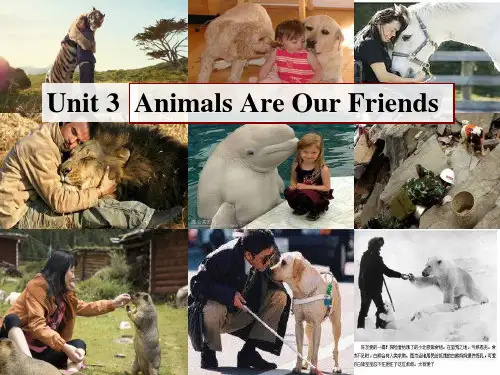
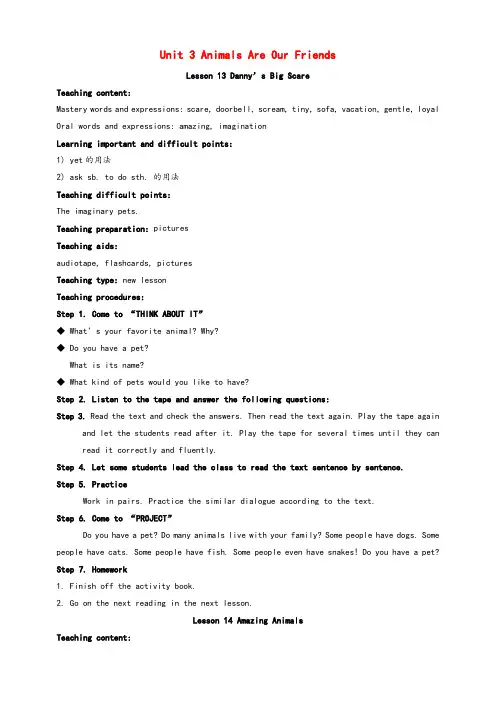
Unit 3 Animals Are Our FriendsLesson 13 Danny’s Big ScareTeaching content:Mastery words and expressions: scare, doorbell, scream, tiny, sofa, vacation, gentle, loyal Oral words and expressions: amazing, imaginationLearning important and difficult points:1) yet的用法2) ask sb. to do sth. 的用法Teaching difficult points:The imaginary pets.Teaching preparation: picturesTeaching aids:audiotape, flashcards, picturesTeaching type: new lessonTeaching procedures:Step 1. Come to “THINK ABOUT IT”◆ What’s your favorite animal? Why?◆ Do you have a pet?What is its name?◆ What kind of pets would you like to have?Step 2. Listen to the tape and answer the following questions:Step 3. Read the text and check the answers. Then read the text again. Play the tape again and let the students read after it. Play the tape for several times until they can read it correctly and fluently.Step 4. Let some students lead the class to read the text sentence by sentence.Step 5. PracticeWork in pairs. Practice the similar dialogue according to the text.Step 6. Come to “PROJECT”Do you have a pet? Do many animals live with your family? Some people have dogs. Some people have cats. Some people have fish. Some people even have snakes! Do you have a pet? Step 7. Homework1. Finish off the activity book.2. Go on the next reading in the next lesson.Lesson 14 Amazing AnimalsTeaching content:Oral words and expressions:long-eared, jerboa, mouse, kiwi, lay, eggplant, shake, flap, avoidLearning important and difficult points1) remind的用法2) lay的用法Teaching preparation: picturesTeaching aids:audiotape, flashcards, picturesType of lesson: new lessonTeaching procedures:Step 1. ReviewStep 2. Come to “THINK ABOUT IT.”◆ Can you name some animals you have never seen before?◆ What animals do you think are amazing? Why?Step 3. Read the text silently and ask the students to answer the following questions: Step 4. Play the tape and let the students read after it. Pause after every line, and ask the students to repeat.Step 5. Let some students read the text in class and the others listen to see if they have any mistakes. Can they find and correct the mistakes?Step 6. Let the students rewrite the story and read it to the class.Step 7.Discuss the reading with the students. Use as much English as possible. Ask questions to make it easier for students to participate.Step 8. HomeworkWould you like to have a pet?Why or why not?Write a paragraph.Lesson 15 The Zoo Is OpenTeaching content:Mastery words and expressions: danger, dangerous, mainly, bamboo, giraffeLearning important and difficult points:1.take photos2.nearly的用法Teaching preparation: picturesType of lesson: new lessonTeaching procedures:Step 1. Show some pictures of animals to the class. Ask the students:What animals do you like best?What animals can you see in the zoo?Step 2. Come to “THINK ABOUT IT.”▲ Have you ever been to the zoo?▲ What animals do you think are dangerous? Why?▲ What rules should we obey at the zoo?Step 3. Read the text.Step 4. PracticeStep 5. Read the text in roles. The teacher walks in the classroom while they are reading.Help them if necessary.Step 6. Let some students come to the front and act the dialogue out.Step 7. HomeworkPrepare the dialogue in group of three in “Let’s Do It”, and act it the next class.Lesson 16 The Bear Escaped!Teaching content:Mastery words and expressions: escape, fierce, protect, foolLearning important and difficult points:1.escape的用法2.if的用法3.wake upTeaching preparation: picturesTeaching aids:audiotape, flashcards, picturesType of lesson: new lessonTeaching procedures:Step 1. Free talkStep 2. Come to “THINK ABOUT IT.”★ When is April Fools’ Day?★ What do people do on that day?★ Have you ever played a trick on a friend? What did you do?Step 3. Listen to the tape and answer the questionsStep 4. Read the text and check the answers. Then let the students read it loudly in class.After a while, ask the students to act it out in front of the class.Step 5. Come to “LET’S DO IT”◆What do you think of the idea of April Fools’ Day?◆ Have you ever played a trick on someone? Share a trick with you partner.◆What do you think “ white lie” means?Step 7. HomeworkDo you know any other interesting foreign festivals?Write them down, and share with your partner next class.Lesson 17 Save the TigersTeaching content:Mastery words and expressions: century, fur, symbol, courage, brave, chain, balance, reason, disappear, kill, cut, decreaseLearning important and difficult points:1) the number of2) balance的用法3) danger的用法Teaching preparations: picturesTeaching aids:audiotape, flashcards, picturesTeaching procedures:Step 1. ReviewStep 2. Come to “THINK ABOUT IT.”Where can you usually see a tiger?Do you think tigers need our help? Why or why not?Step 3. Listen to the tape and repeat after it. Play the tape for several until they can read it correctly and fluently.Step 4. Let some students act the dialogue out in front of the class.Step 8. HomeworkWork in groups and discuss some ways we can protect animals. Write down your ideas.Lesson 18 Friendship Between AnimalsTeaching content:Mastery words and expressions: friendship, rhino, skin, warn, insect, relationship, survive, mzee, hippo, tortoise, truly, boundaryLearning important and difficult points:1) use的用法2) warn的用法Teaching preparation: picturesTeaching aids:audiotape, flashcards, picturesType of lesson: new lessonTeaching procedures:Step 1. Come to “THINK ABOUT IT”◆Do you think there is friendship between animals?◆ What different animals have you seen living well together?Step 2. Listen to the tape and let some students retell the main idea about the text. If they can’t do well, don’t publish them. Encourage them and say: “I know it is very difficult for you. It’s also difficult for me. Let’s face the problem together.”Step 3. Read the text silently and answer the questionsStep 4. ExerciseStep 5. HomeworkWhat will you do if you go to the zoo?Do you know anything that we cannot do in the zoo? Why?Think about it, and write a short paragraph.。
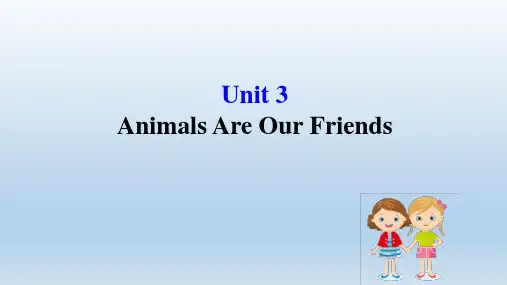
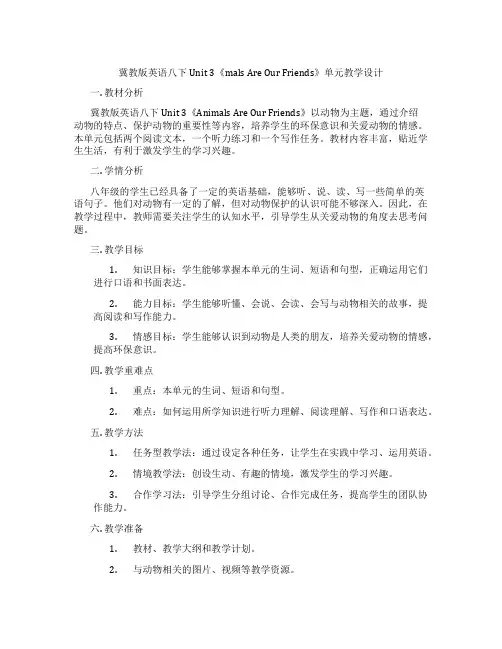
冀教版英语八下Unit 3《mals Are Our Friends》单元教学设计一. 教材分析冀教版英语八下Unit 3《Animals Are Our Friends》以动物为主题,通过介绍动物的特点、保护动物的重要性等内容,培养学生的环保意识和关爱动物的情感。
本单元包括两个阅读文本,一个听力练习和一个写作任务。
教材内容丰富,贴近学生生活,有利于激发学生的学习兴趣。
二. 学情分析八年级的学生已经具备了一定的英语基础,能够听、说、读、写一些简单的英语句子。
他们对动物有一定的了解,但对动物保护的认识可能不够深入。
因此,在教学过程中,教师需要关注学生的认知水平,引导学生从关爱动物的角度去思考问题。
三. 教学目标1.知识目标:学生能够掌握本单元的生词、短语和句型,正确运用它们进行口语和书面表达。
2.能力目标:学生能够听懂、会说、会读、会写与动物相关的故事,提高阅读和写作能力。
3.情感目标:学生能够认识到动物是人类的朋友,培养关爱动物的情感,提高环保意识。
四. 教学重难点1.重点:本单元的生词、短语和句型。
2.难点:如何运用所学知识进行听力理解、阅读理解、写作和口语表达。
五. 教学方法1.任务型教学法:通过设定各种任务,让学生在实践中学习、运用英语。
2.情境教学法:创设生动、有趣的情境,激发学生的学习兴趣。
3.合作学习法:引导学生分组讨论、合作完成任务,提高学生的团队协作能力。
六. 教学准备1.教材、教学大纲和教学计划。
2.与动物相关的图片、视频等教学资源。
3.录音机、投影仪等教学设备。
4.作业本、测试卷等教学资料。
七. 教学过程1.导入(5分钟)利用图片、视频等资源,引导学生谈论自己喜欢的动物,激发学生的学习兴趣。
2.呈现(10分钟)介绍本节课的主题,展示本节课的生词、短语和句型。
通过生动、有趣的方式,让学生感知和理解新知识。
3.操练(15分钟)采用任务型教学法,让学生在各种情境中练习新知识。
例如,分组讨论动物的特点,用英语进行描述;角色扮演,模拟与动物相关的场景等。
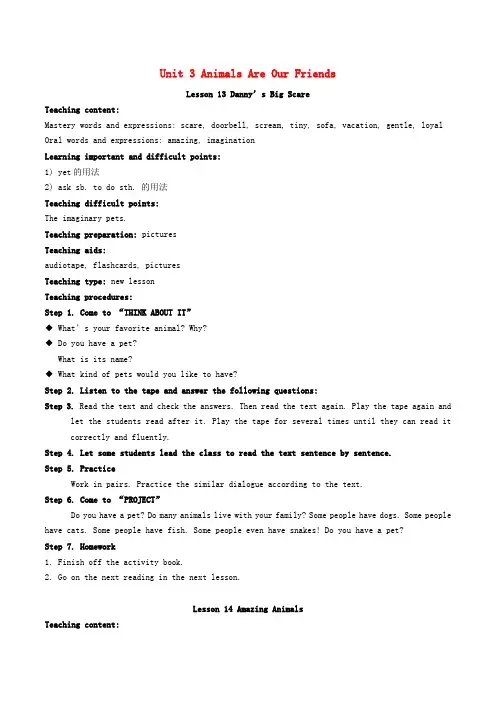
Unit 3 Animals Are Our FriendsLesson 13 Danny’s Big ScareTeaching content:Mastery words and expressions: scare, doorbell, scream, tiny, sofa, vacation, gentle, loyal Oral words and expressions: amazing, imaginationLearning important and difficult points:1) yet的用法2) ask sb. to do sth. 的用法Teaching difficult points:The imaginary pets.Teaching preparation: picturesTeaching aids:audiotape, flashcards, picturesTeaching type: new lessonTeaching procedures:Step 1. Come to “THINK ABOUT IT”◆ What’s your favorite animal? Why?◆ Do you have a pet?What is its name?◆ What kind of pets would you like to have?Step 2. Listen to the tape and answer the following questions:Step 3. Read the text and check the answers. Then read the text again. Play the tape again and let the students read after it. Play the tape for several times until they can read it correctly and fluently.Step 4. Let some students lead the class to read the text sentence by sentence.Step 5. PracticeWork in pairs. Practice the similar dialogue according to the text.Step 6. Come to “PROJECT”Do you have a pet? Do many animals live with your family? Some people have dogs. Some people have cats. Some people have fish. Some people even have snakes! Do you have a pet?Step 7. Homework1. Finish off the activity book.2. Go on the next reading in the next lesson.Lesson 14 Amazing AnimalsTeaching content:Oral words and expressions:long-eared, jerboa, mouse, kiwi, lay, eggplant, shake, flap, avoid Learning important and difficult points1) remind的用法2) lay的用法Teaching preparation: picturesTeaching aids:audiotape, flashcards, picturesType of lesson: new lessonTeaching procedures:Step 1. ReviewStep 2. Come to “THINK ABOUT IT.”◆ Can you name some animals you have never seen before?◆ What animals do you think are amazing? Why?Step 3. Read the text silently and ask the students to answer the following questions:Step 4. Play the tape and let the students read after it. Pause after every line, and ask the students to repeat.Step 5. Let some students read the text in class and the others listen to see if they have any mistakes. Can they find and correct the mistakes?Step 6. Let the students rewrite the story and read it to the class.Step 7. Discuss the reading with the students. Use as much English as possible. Ask questions to make it easier for students to participate.Step 8. HomeworkWould you like to have a pet?Why or why not?Write a paragraph.Lesson 15 The Zoo Is OpenTeaching content:Mastery words and expressions: danger, dangerous, mainly, bamboo, giraffeLearning important and difficult points:1.take photos2.nearly的用法Teaching preparation: picturesType of lesson: new lessonTeaching procedures:Step 1. Show some pictures of animals to the class. Ask the students:What animals do you like best?What animals can you see in the zoo?Step 2. Come to “THINK ABOUT IT.”▲ Have you ever been to the zoo?▲ What animals do you think are dangerous? Why?▲ What rules should we obey at the zoo?Step 3. Read the text.Step 4. PracticeStep 5. Read the text in roles. The teacher walks in the classroom while they are reading. Help them if necessary.Step 6. Let some students come to the front and act the dialogue out.Step 7. HomeworkPrepare the dialogue in group of three in “Let’s Do It”, and act it the next class.Lesson 16 The Bear Escaped!Teaching content:Mastery words and expressions: escape, fierce, protect, foolLearning important and difficult points:1.escape的用法2.if的用法3.wake upTeaching preparation: picturesTeaching aids:audiotape, flashcards, picturesType of lesson: new lessonTeaching procedures:Step 1. Free talkStep 2. Come to “THINK ABOUT IT.”★ When is April Fools’ Day?★ What do people do on that day?★ Have you ever played a trick on a friend? What did you do?Step 3. Listen to the tape and answer the questionsStep 4. Read the text and check the answers. Then let the students read it loudly in class. Aftera while, ask the students to act it out in front of the class.Step 5. Come to “LET’S DO IT”◆What do you thin k of the idea of April Fools’ Day?◆ Have you ever played a trick on someone? Share a trick with you partner.◆What do you think “ white lie” means?Step 7. HomeworkDo you know any other interesting foreign festivals?Write them down, and share with your partner next class.Lesson 17 Save the TigersTeaching content:Mastery words and expressions: century, fur, symbol, courage, brave, chain, balance, reason, disappear, kill, cut, decreaseLearning important and difficult points:1) the number of2) balance的用法3) danger的用法Teaching preparations: picturesTeaching aids:audiotape, flashcards, picturesTeaching procedures:Step 1. ReviewStep 2. Come to “THINK ABOUT IT.”Where can you usually see a tiger?Do you think tigers need our help? Why or why not?Step 3. Listen to the tape and repeat after it. Play the tape for several until they can read it correctly and fluently.Step 4. Let some students act the dialogue out in front of the class.Step 8. HomeworkWork in groups and discuss some ways we can protect animals. Write down your ideas.Lesson 18 Friendship Between AnimalsTeaching content:Mastery words and expressions: friendship, rhino, skin, warn, insect, relationship, survive, mzee, hippo, tortoise, truly, boundaryLearning important and difficult points:1) use的用法2) warn的用法Teaching preparation: picturesTeaching aids:audiotape, flashcards, picturesType of lesson: new lessonTeaching procedures:Step 1. Come to “THINK ABOUT IT”◆Do you think there is friendship between animals?◆ What different animals have you seen living well together?Step 2. Listen to the tape and let some students retell the main idea about the text. If they can’t do well, don’t publish them. Encourage them and say: “I know it is very difficult for you. It’s also difficult for me. Let’s face the problem together.”Step 3. Read the text silently and answer the questionsStep 4. ExerciseStep 5. HomeworkWhat will you do if you go to the zoo?Do you know anything that we cannot do in the zoo? Why?Think about it, and write a short paragraph.。
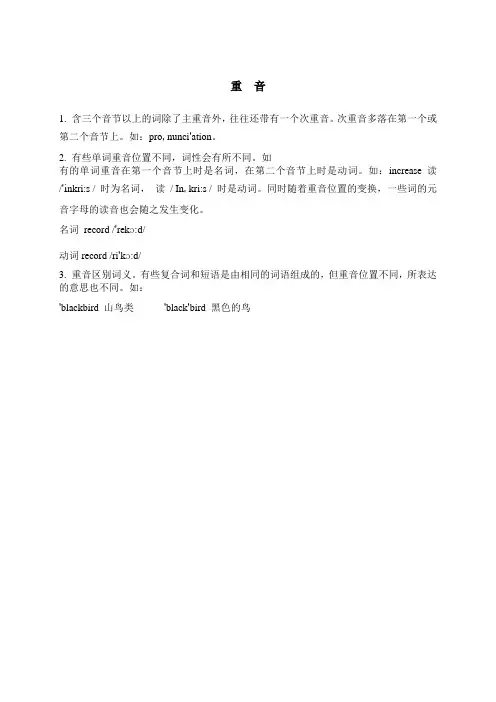
重音
1. 含三个音节以上的词除了主重音外,往往还带有一个次重音。
次重音多落在第一个或
nunci'ation。
第二个音节上。
如:pro
'
2. 有些单词重音位置不同,词性会有所不同。
如
有的单词重音在第一个音节上时是名词,在第二个音节上时是动词。
如:increase读/'i nkri:s / 时为名词,读/ In'kri:s / 时是动词。
同时随着重音位置的变换,一些词的元音字母的读音也会随之发生变化。
名词record /'rekɔ:d/
动词record /ri'kɔ:d/
3. 重音区别词义。
有些复合词和短语是由相同的词语组成的,但重音位置不同,所表达的意思也不同。
如:
'blackbird 山鸟类'black'bird 黑色的鸟。
Unit 3 Animals Are Our FriendsLesson 15 The Zoo Is OpenLESSON PREPARATIONLANGUAGE KNOWLEDGE掌握词汇:danger, dangerous, bamboo, giraffe接触词汇:mainly短语和句型:instead ofRESOURCESaudiotapeLESSON STRUCTURECLASS OPENING GreetingGreet the class.Teacher: Good morning/afternoon, everyone. Good to see you. Before we start today's lesson, let's try some tongue twisters.Write some animal-related tongue twisters on the board. Read through each with the class and explain the meaning of each one. Then give the students some time to practice on their own. After they've had some time to practice, ask some volunteers to stand and see if they can say the tongue twister three times faster.Sample tongue twisters:The big bug bit the little beetle,but the little beetle bit the big bug back. Fuzzy wuzzy was a bear.Fuzzy wuzzy wasn't very fuzzy, was he?Review1)Homework check.2)Choose some students to present their "Amazing Animal".3)Review the use of indefinite pronouns "some" and "any".Teacher: When it's a friend's birthday, what do you usually do for him or her? Students: When it's a friend's birthday, I usually buy them a present./When it's my friend's birthday, I usually make them a cake./When it's my friend's birthday, I singthem "Happy Birthday"./etc.Teacher: Very nice. You are all such good friends. Students: They are interesting/fun/difficult/easy. Teacher: Well done!KEY CONCEPTSFOCUS STRUCTURES:They go through the entrance and see a sign.And maybe you could eat some carrots instead of all those donuts.STEP 1: PresentCLASS WORK: Discussion and Think About It 1) Introduce Lesson 15 and have a class discussion. Teacher: In this lesson, Jenny, Danny and Brian go to the zoo. What is a zoo? Have you ever been to the zoo? Do you like the zoo?Students: A zoo is a place where they keep animals. I've been to the zoo. I love the zoo. I think it's fun to see and learn about the animals there.Teacher: What animals do you see at the zoo?Students: Pandas, lions, monkeys, elephants, bears, etc.Write a list of animals on the board and be sure to include the giraffe in the list. Students should master this word.Teacher: That's right. Are there any animals at the zoo that scare you? Why or why not?Students: Yes. I'm afraid of lions. They have big teeth and they can eat you./No, I'm not scared of the animals at the zoo because they are in cages.Teacher: Some animals can be dangerous. Dangerous is something that is not safe. How do you say dangerous in Chinese?Students:危险的。
Unit 3 Animals Are Our FriendsLesson 13 Danny’s Big ScareTeaching content:Mastery words and expressions: scare, doorbell, scream, tiny, sofa, vacation, gentle, loyal Oral words and expressions: amazing, imaginationLearning important and difficult points:1) yet的用法2) ask sb. to do sth. 的用法Teaching difficult points:The imaginary pets.Teaching preparation: picturesTeaching aids:audiotape, flashcards, picturesTeaching type: new lessonTeaching procedures:Step 1. Come to “THINK ABOUT IT”◆ What’s your favorite animal? Why?◆ Do you have a pet?What is its name?◆ What kind of pets would you like to have?Step 2. Listen to the tape and answer the following questions:Step 3. Read the text and check the answers. Then read the text again. Play the tape again and let the students read after it. Play the tape for several times until they can read it correctly and fluently.Step 4. Let some students lead the class to read the text sentence by sentence.Step 5. PracticeWork in pairs. Practice the similar dialogue according to the text.Step 6. Come to “PROJECT”Do you have a pet? Do many animals live with your family? Some people have dogs. Some people have cats. Some people have fish. Some people even have snakes! Do you have a pet?Step 7. Homework1. Finish off the activity book.2. Go on the next reading in the next lesson.Lesson 14 Amazing AnimalsTeaching content:Oral words and expressions:long-eared, jerboa, mouse, kiwi, lay, eggplant, shake, flap, avoid Learning important and difficult points1) remind的用法2) lay的用法Teaching preparation: picturesTeaching aids:audiotape, flashcards, picturesType of lesson: new lessonTeaching procedures:Step 1. ReviewStep 2. Come to “THINK ABOUT IT.”◆ Can you name some animals you have never seen before?◆ What animals do you think are amazing? Why?Step 3. Read the text silently and ask the students to answer the following questions:Step 4. Play the tape and let the students read after it. Pause after every line, and ask the students to repeat.Step 5. Let some students read the text in class and the others listen to see if they have any mistakes. Can they find and correct the mistakes?Step 6. Let the students rewrite the story and read it to the class.Step 7. Discuss the reading with the students. Use as much English as possible. Ask questions to make it easier for students to participate.Step 8. HomeworkWould you like to have a pet?Why or why not?Write a paragraph.Lesson 15 The Zoo Is OpenTeaching content:Mastery words and expressions: danger, dangerous, mainly, bamboo, giraffeLearning important and difficult points:1.take photos2.nearly的用法Teaching preparation: picturesType of lesson: new lessonTeaching procedures:Step 1. Show some pictures of animals to the class. Ask the students:What animals do you like best?What animals can you see in the zoo?Step 2. Come to “THINK ABOUT IT.”▲ Have you ever been to the zoo?▲ What animals do you think are dangerous? Why?▲ What rules should we obey at the zoo?Step 3. Read the text.Step 4. PracticeStep 5. Read the text in roles. The teacher walks in the classroom while they are reading. Help them if necessary.Step 6. Let some students come to the front and act the dialogue out.Step 7. HomeworkPrepare the dialogue in group of three in “Let’s Do It”, and act it the next class.Lesson 16 The Bear Escaped!Teaching content:Mastery words and expressions: escape, fierce, protect, foolLearning important and difficult points:1.escape的用法2.if的用法3.wake upTeaching preparation: picturesTeaching aids:audiotape, flashcards, picturesType of lesson: new lessonTeaching procedures:Step 1. Free talkStep 2. Come to “THINK ABOUT IT.”★ When is April Fools’ Day?★ What do people do on that day?★ Have you ever played a trick on a friend? What did you do?Step 3. Listen to the tape and answer the questionsStep 4. Read the text and check the answers. Then let the students read it loudly in class. Aftera while, ask the students to act it out in front of the class.Step 5. Come to “LET’S DO IT”◆What do you think of the idea of April Fools’ Day?◆ Have you ever played a trick on someone? Share a trick with you partner.◆What do you think “ white lie” means?Step 7. HomeworkDo you know any other interesting foreign festivals?Write them down, and share with your partner next class.Lesson 17 Save the TigersTeaching content:Mastery words and expressions: century, fur, symbol, courage, brave, chain, balance, reason, disappear, kill, cut, decreaseLearning important and difficult points:1) the number of2) balance的用法3) danger的用法Teaching preparations: picturesTeaching aids:audiotape, flashcards, picturesTeaching procedures:Step 1. ReviewStep 2. Come to “THINK ABOUT IT.”Where can you usually see a tiger?Do you think tigers need our help? Why or why not?Step 3. Listen to the tape and repeat after it. Play the tape for several until they can read it correctly and fluently.Step 4. Let some students act the dialogue out in front of the class.Step 8. HomeworkWork in groups and discuss some ways we can protect animals. Write down your ideas.Lesson 18 Friendship Between AnimalsTeaching content:Mastery words and expressions: friendship, rhino, skin, warn, insect, relationship, survive, mzee, hippo, tortoise, truly, boundaryLearning important and difficult points:1) use的用法2) warn的用法Teaching preparation: picturesTeaching aids:audiotape, flashcards, picturesType of lesson: new lessonTeaching procedures:Step 1. Come to “THINK ABOUT IT”◆Do you think there is friendship between animals?◆ What different animals have you seen living well together?Step 2. Listen to the tape and let some students retell the main idea about the text. If they can’t do well, don’t publish them. Encourage them and say: “I know it is very difficult for you. It’s also difficult for me. Let’s face the problem together.”Step 3. Read the text silently and answer the questionsStep 4. ExerciseStep 5. HomeworkWhat will you do if you go to the zoo?Do you know anything that we cannot do in the zoo? Why?Think about it, and write a short paragraph.。
重点句子讲解1. He hasn’t been to the zoo in Edmonton yet. 他还没有去过埃德蒙顿动物园。
yet用法归纳:(1) yet作副词,用于否认句中,常置于句末,也可用于not后,表示“到此时,至今还没……〞。
如:We have had no news from him yet. 我们还没有他的消息。
(2) yet用于疑问句,表示“已经;还〞。
如:Has your brother arrived yet? 你哥哥已经到了吗?(3) yet用于肯定句中,表示“还;更〞等。
如:This problem is yet more difficult. 这个问题更难。
(4) yet用作连词,表示“然而;可是〞。
如:He worked hard, yet he failed. 他工作努力,可是他失败了。
■知识链接already也表示“已经〞,通常用于肯定句中,常置于助动词之后、行为动词之前。
如:。
He has already gone there. 他已经去那儿了。
have been to 意为“去过某地〞,表示一种经历,含有现在以离开那儿之意。
后接次数〔如:once,twice,many times〕时,表示“去过某地几次〞,也可和just, never, ever 等词连用。
如:I have never been to the Great Wall. 我从来没有去过长城。
■知识链接have gone to 意为“去某地了〞,表示某人去某地还未归来。
如:—Where is John? 约翰在哪里?—He has gone to England. 他去英国了。
〔尚未回来〕have been in 表示“在某地多长时间了〞,常与时间段连用。
如:My brother has been in England for three years. 我哥哥已经在英国三年了。
2. Her family went on a vacation and she asked me to take care of Zoe. 她的家人去度假了,她要我照顾佐伊。
本文由一线教师精心整理/word 可编辑1 / 1Unit3 Animals Are Our FriendsLesson15教案 一 、Teaching content:(教学内容)1. New words and phrases: dangerous, mainly, bamboo, giraffe, instead of.2. Understand the meaning of text.3.Grammar: Indefinite Pronouns(some, any) 二、Teaching goal s :(教学目标)1. Master the new words and phrases, understand the meaning of text.2.Talk about the animals in the zoo.3.Make the Ss know why we need animals. 三、Key points:(重点) Talk about the animals in the zoo. 四、Difficult points:(难点)Make the Ss know why we need animals. 五、Teaching aids:(教学辅助) PPT六、Type of the lesson:(课程类型) New lesson. 七、Teaching procedure :(教学过程) Step 1.Analysis of the student.(学生分析) Homework check.Review: Ask some Ss to talk about the animals in lesson 14.We learned about some special animals and we knew the difference between the animals and the pets. Step 2. Lead in.(引入)Greet the students in English and make sure they can response correctly. Do the duty report: a student on duty can say whatever he/she likes to say. Come to “Think about It!”What animals do you think are dangerous? Why? What rules should we obey at the zoo? Step 3. New lesson.(新课) No. 1 Prepare lessons before class. Come to the vocabulary.Teach the new words and phrases. Make sure the Ss can read it correctly.No. 2 Text: Give them some time to read the text themselves. Then let them ac t out the dialogue in groups. Correct their pronunciat ion when necessary.At last, the teacher explains the text in Chinese, make sure the Ss can understand the meaning o f text.No. 3 Important phrases:go to the zoo arrive at go throu gh point to take photos wake up lots of instead ofNo. 4 Project: We’re going to the zoo!Have you ever visit ed a zoo? Write a story about trip to the zoo. Don’t forget to answer these questions:When did you go to the zoo? Who went t o the zoo with you? What animals did you see?What animals did you like best? Why? Did you feed any animals?Are zoos good for animals? Why or why not? No. 5 Finish “Let’s Do It!”Step 4. Play the tape for the Ss to follow.Make the Ss listen the text, then let them read follow the tape. Step 5.Summary. (小结)Sum up the text what we learned, the new words, phrases, and sentences. Sum up the grammar. Step 6. Homework.(作业)Finish the activity book and the practice. Copy the new words and phrases twice. Step 7.Blackboard-writing:(板书)The new words, the master phrases, importa nt sentences. The grammar and practice.八.Teaching reflection:(教后反思)。
第13—15课每课一练Lesson 13I、根据括号中所给的汉语用适当的词语填空。
(5分)1、We have two long ____________(假期)every year、2、How many ___________(沙发)are there in the hall?3、What a __________(微小的)animal this is!4、Many animals are very __________(温柔的), but some aren’t、5、A strange thing ___________(发生)to me last night、II、根据句意用适当的介词填空。
(5分)1、Emily is taking care __________ her mother at home、2、I think we should be friendly ___________ each other、3、Her sister is afraid __________ cats and dogs、4、The Smith family went to Beijing __________ a holiday、5、Sometimes animals help people __________ something important、III、根据所给汉语,完成英语句子,每空一词。
(10分)1、刚才李明径直跑回家。
Li Ming ran __________ ________ __________ to his home just now、2、您以前去过动物园不?Have you _____________ _____________ the zoo before?3、她请我与她一起去动物园。
She asked _____________ ___________ __________ to the zoo with her、4、她对她的宠物很友好。
He is very _____________ ____________ his pet、5、昨天丹尼那儿发生什么事了?____________ __________ ___________ Danny yesterday?IV、按要求进行句式转换,每空一词。
(10分)1、There are some new animals at the zoo、(改为一般疑问句)___________ __________ __________ new animals at the zoo?2、A small cat jumped off the box、(改为否定句)A small cat ____________ ___________ off the box、3、Cats likes to eat fish、(对划线部分提问)___________ _________ cats like to eat?4、Jenny goes to open the door、(改为反意疑问句)Jenny goes to open the door, ___________ __________?5、The cat is running quickly、(改为感叹句)____________ __________ the cat is running!Lesson 14I、根据括号中所给的汉语用适当的词语填空。
(5分)1、There are many ____________(老鼠)in this old house、2、What about _____________(摇动)the bottle with one hand?3、In a text message, you can ___________(回避)eye contact、4、This bird ____________(产卵)in its own nest、5、Look at that eagle、It has two big ____________(翅膀)、II、按要求改写句子,每空一词。
(10分)1、This kind of bird lives in the desert、(对划线部分提问)____________ _________ this kind of bird live?2、These monkeys are excited、(改为感叹句)_____________ ____________ these monkeys are!3、He jumped into the cool river just now、(改为否定句)He _____________ ___________ into the cool river just now、4、This flower looks like a bird、(对划线部分提问)___________ __________ this bird look like?5、You can see flying fish all over the world、(改为同义句)____________ __________ flying fish all over the world、III、根据所给汉语,完成下列句子,每空一词。
(10分)1、这种动物让人们想起了猫。
This kind of animal ___________ ____________ ____________ cats、2、它的头像苹果一样大。
Its head is _____________ ____________ _____________ an apple、3、您为什么要拒绝我呢?Why did you _____________ __________ ___________ me?4、袋鼠生活在什么地方呢?______________ ____________ kangaroos live?5、埃及以以什么出名呢?What is Egypt ______________ _____________?IV、下列每句话中有一处错误,请找出来并加以改正。
(10分)1、This animal is much big than that one、__________________________________________________________ 2、The bird flew into the sky followed its friends、__________________________________________________________ 3、They told us a piece of excited news about those animals、__________________________________________________________ 4、What a cute animal is this!__________________________________________________________ 5、Most of them likes this kind of animal、__________________________________________________________Lesson 15I、根据句意用适当的介词填空。
(5分)1、They arrived __________ the zoo after us、2、Here are some donuts _________ you, Danny、You can eat them、3、The giraffe’s neck is very long、What does it look __________?4、You can eat bread instead ___________ donuts today、5、Danny, you can’t feed animals __________ donuts!II、根据句意与所给的首字母用适当的词语填空。
(10分)1、B_____________ is the tallest grass in the world、2、It’s too d_____________ to play in the street、You can play at the square、3、Today is Sunday and we don’t have c___________、4、You can go t____________ the entrance and walk inside the zoo、5、She told us a f___________ story and we all laughed and laughed、III、用括号中所给动词的适当形式填空。
(10分)1、Have you ___________ (see) the sign on the wall?2、Rabbits like ____________ (eat) grass and carrots、3、He has a good memory and he ____________ (remember) things very quickly、4、__________ (feed) animals at the zoo is wrong、You can’t do it again、5、What makes her __________ (think) this animal likes donuts?IV、根据所给汉语,完成下列句子,每空一词。
(10分)1、李明,快醒醒。
Li Ming, ______________ ____________ quickly、2、为什么在动物园不能投喂动物?Why not _______________ ___________ in the zoo?3、明天参观动物园怎么样?How ____________ ____________ the zoo tomorrow?4、她请我给她照张像。
She asked me ____________ ___________ photos for her、5、黑龙江没有竹子。
____________ _________ __________ bamboos in Heilongjiang、第13—15课每课一练参考答案Lesson 13I、1、vacations 2、sofas 3、tiny 4、gentle 5、happenedII、1、of 2、to 3、of 4、for 5、withIII、1、all the way 2、been to 3、me to go 4、friendly to 5、What happened toIV、1、Are there any 2、didn’t jump 3、What do 4、doesn’t she 5、How quickly Lesson 14I、1、mice 2、shaking 3、avoid 4、lays 5、wingsII、1、Where does 2、How excited 3、didn’t jump 4、What does 5、There areIII、1、reminds people of 2、as big as 3、say no to 4、Where do 5、famous forIV、1、big改为bigger 2、followed改为to follow 3、excited改为exciting 4、is this改为this is 5、likes改为likeLesson 15I、1、at 2、for 3、like 4、of 5、withII、1、Bamboo 2、dangerous 3、classes 4、through 5、funnyIII、1、seen 2、eating 3、remembers 4、Feeding 5、thinkIV、1、wake up 2、feed animals 3、about visiting 4、to take 5、There are no。